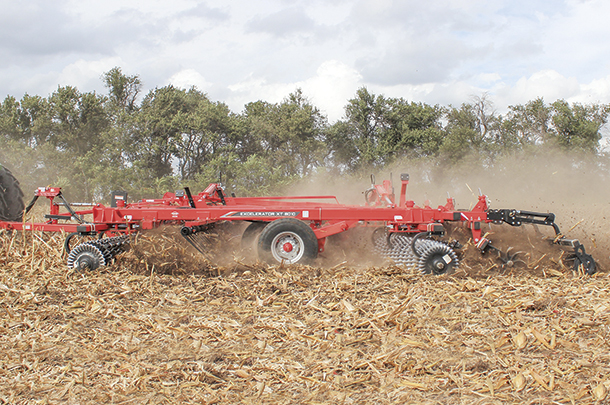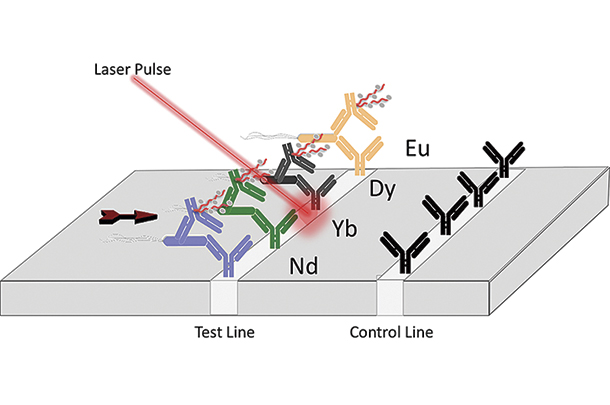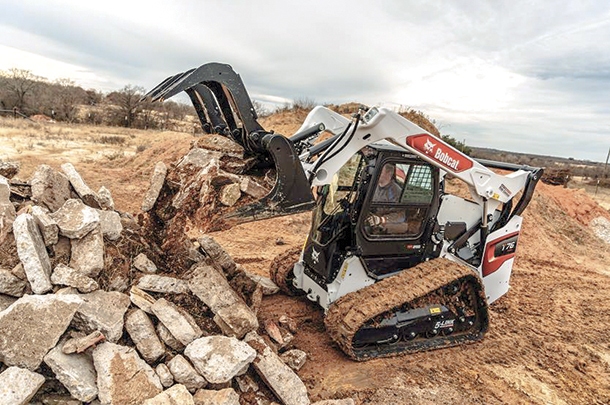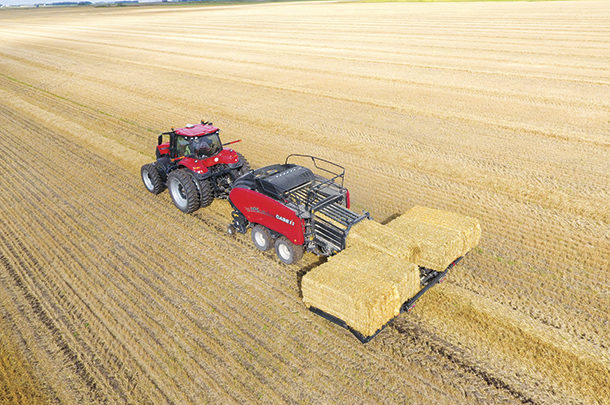Designed for simplicity and handling a variety of bale sizes and conditions, the new large square baler accumulator is fully automatic, providing peace of mind so operators can concentrate on the baling process and not bales on deck. The accumulator is available in horizontal and vertical models, creating neatly placed groups of bales ready for pickup.
The new accumulator requires no daily maintenance and is compatible with closed-center, open-center and closed-center load sensing hydraulic systems. When the accumulator reaches capacity, the bales are automatically ejected off the deck and ready for handling. An in-cab monitor allows the operator to see how many bales are on deck and to manually eject bales at any time should the need arise.
The new large square baler accumulator reduces loading time by up to 50% and collects up to five bales, depending on the model, and automatically groups bales in the desired dump pattern – stacked or horizontal. It is available in four models to meet various bale sizes and horizontal or vertical stacking requirements. For horizontal stacking, a standard three-bale accumulator is available in two models: the AC3108 for 3X3 bales and the AC4108 for 4X3 bales. For larger operations, there is now a five-bale accumulator option: the AC5150. For vertical stacking needs, the VS1208 stacks three 4-foot-wide bales neatly for easy loading.
In addition to adding a lineup of large square baler accumulators to its equipment portfolio, the company is making updates to its large square baler models available on new model year 2020 balers. The TwinePro knotter ensures the perfect finish for bales with the addition of a second loop knot, improving the knot strength by up to 30%. Bale density may be increased by using the same twine, or current bale density may be maintained by using lower-strength twine. The new knotting technique eliminates the twine off-cuts, making a more environmentally friendly baler. With previous baler models, a producer creates upward of 9,800 feet of off-cuts per year.

KUHN Krause Excelerator XT 8010 can extend your vertical tillage options
Kuhn North America Inc. is pleased to introduce the new KUHN Krause Excelerator XT 8010 vertical tillage system. While retaining an 1- to 5-degree vertical tillage gang angle range for true VT performance, the new tool features an additional extended range of 6 to 8 degrees. Double-digit gang angles of 10 degrees or greater were avoided to maintain performance metrics. The added capability to increase gang angle will assist the operator in removing shallow-rooted weed growth or filling light ruts created from previous harvest traffic or sprayer passes.
Individual gang angles adjust using a standard mechanical screw adjustment, or an optional hydraulic “on-the-go” adjustment feature is available. The hydraulic option includes an “in-cab” selector that allows the operator to move front and rear gangs simultaneously and retain the same gang angles front to rear. Or the operator can adjust the front and rear gangs independently, varying the front and rear gang angle.
Additional features include: combination 7-inch front-blade and 8-inch rear-blade spacing, a mid-mounted heavy-duty tine section, no-daily grease maintenance bearings, constant-flow hydraulic down-pressure adjustment for wing sections, plus the Star Wheel treader finishing attachment and 24/7 conditioning reel. The 32-flute, 22-inch, Excalibur VT blades continue to provide exceptional blade life and retain a cutting edge as they wear, when operated at 8 degrees or less.
Designed to operate at 8 to 10 mph field speeds throughout the gang angle range, the new model provides producers with a versatile and productive “high speed” vertical tillage tool that is proficient in either fall or spring tillage applications. Currently available in 30-foot, 34-foot and 40-foot sizes, the Excelerator XT continues to offer features and benefits recognized by today’s top producers.

New technology for pathogen detection driven by lasers
Researchers at Purdue University have been working to develop new technologies to help stop the spread of foodborne illnesses, which kill 3,000 people a year, by detecting them more efficiently. They have developed a lanthanide-based assay coupled with a laser that can be used to detect toxins and pathogenic E. coli in food samples, water and a variety of industrial materials.
The two key features of the new technology are the incorporation of lanthanides and simple, lateral-flow, paper-based assays. The Purdue team created a method for combining different heavy metals that when linked to antibodies can detect multiple agents in a single analysis. The Purdue team’s work is published in the January edition of Analytical and Bioanalytical Chemistry.
The innovators worked with the Purdue Research Foundation Office of Technology Commercialization to patent the technology in the U.S. and in Europe. They are looking for partners. For more information, contact Dipak Narula of OTC via email and use reference track code 2019-ROBI-68413.
The group is evaluating the potential for fully portable use that would allow field use in virtually any environment.
The approach uses a high-powered laser pulse to obliterate a sample, while simultaneously collecting the spectral signature of the resultant emission. These signals are then compared with a database that translates the signals into an identification of the toxin or pathogen.
The work presented in this paper shows the proof of principle and is the basis for significant expansion of the studies. What makes the technology effective is the linking of antibodies to different heavy metal tags. This creates a unique fingerprint of atomic signatures that can be used to determine if any particular pathogen of interest is present in a sample.
The USDA Agricultural Research Service (ARS) and Center for Food Safety Engineering (CFSE) provided funding for the technology research in addition to Hatch Funds, which supports agricultural research at land-grant institutions across the U.S.

Bobcat Co. introduces next-generation R-Series compact loaders with a revolutionary redesign
The first R-Series loaders to launch will include the Bobcat T76 compact track loader and the S76 skid steer loader. Additional R-Series loaders from Bobcat will be introduced at a later date.
Designed to tackle both everyday work and the toughest challenges, the new R-Series loaders have been redesigned inside and outside to be the most powerful, durable loaders built by the company. With a total focus on quality, the R-Series loaders offer uncompromising reliability and durability, enhanced performance and an unmatched operator experience.
Increased lift capabilities
R-Series loaders not only look tougher, they are tougher. R-Series loaders are equipped with redesigned lift arms for increased lifting capability. New lift arms feature cast steel sections that provide greater strength while enabling a slimmer-profile arm that also enhances visibility.
Redesigned cooling system
As operators trust compact equipment to run longer and do bigger, more difficult jobs, better cooling is essential. These loaders have a redesigned cooling system for optimal operation and maximum uptime. These improvements have significantly reduced operating temperatures of key components, providing increased reliability and durability. In addition, the fan size has been increased by approximately 50%, which achieves more cooling at a slower rotation.
Optional clear-side enclosure
With their leading all-around visibility, comfortable controls, numerous options and roomy environment, these loaders bring more comfort to challenging jobs. The optional clear-side enclosure and mesh-free windows allows operators to easily see the sides of the machine and maneuver more confidently. Plus, these loaders come standard with LED lights for far-reaching visibility in low-light situations. Operators can also upgrade to optional premium LED lights, which wrap around the cab’s upper corners to illuminate more of the jobsite. An optional backup camera also gives an optimal view of the jobsite.
One-piece sealed and pressurized cab
The new cab design is a one-piece, sealed and pressurized design for a new level of comfort and improved service access. The design repels dust and dirt in the cab, helps isolate engine and hydraulic noise, and enhances the efficiency of optional heating and air conditioning. When it’s time for maintenance or repairs, the entire cab rotates out of the way to provide improved service access – with hardware on the cab exterior for easy removal. ![]()
—Compiled by Progressive Forage staff
PHOTOS: Photos courtesy of Case IH, Kuhn North America Inc., Purdue University and Bobcat Co.










